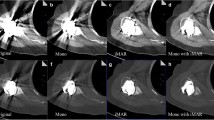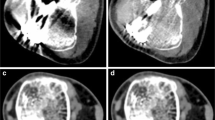Abstract
Objective
To determine whether a simulated low-dose metal artifact reduction (MAR) CT technique is comparable with a clinical dose MAR technique for shoulder arthroplasty evaluation.
Materials and methods
Two shoulder arthroplasties in cadavers and 25 shoulder arthroplasties in patients were scanned using a clinical dose (140 kVp, 300 qrmAs); cadavers were also scanned at half dose (140 kVp, 150 qrmAs). Images were reconstructed using a MAR CT algorithm at full dose and a noise-insertion algorithm simulating 50% dose reduction. For the actual and simulated half-dose cadaver scans, differences in SD for regions of interest were assessed, and streak artifact near the arthroplasty was graded by 3 blinded readers. Simulated half-dose scans were compared with full-dose scans in patients by measuring differences in implant position and by comparing readers’ grades of periprosthetic osteolysis and muscle atrophy.
Results
The mean difference in SD between actual and simulated half-dose methods was 2.42 HU (95% CI [1.4, 3.4]). No differences in streak artifact grades were seen in 13/18 (72.2%) comparisons in cadavers. In patients, differences in implant position measurements were within 1° or 1 mm in 149/150 (99.3%) measurements. The inter-reader agreement rates were nearly identical when readers were using full-dose (77.3% [232/300] for osteolysis and 76.9% [173/225] for muscle atrophy) and simulated half-dose (76.7% [920/1200] for osteolysis and 74.0% [666/900] for muscle atrophy) scans.
Conclusion
A simulated half-dose MAR CT technique is comparable both quantitatively and qualitatively with a standard-dose technique for shoulder arthroplasty evaluation, demonstrating that this technique could be used to reduce dose in arthroplasty imaging.






Similar content being viewed by others
References
White LM, Buckwalter KA. Technical considerations: CT and MR imaging in the postoperative orthopedic patient. Semin Musculoskelet Radiol. 2002;6(1):5–17.
Katsura M, Sato J, Akahane M, Kunimatsu A, Abe O. Current and novel techniques for metal artifact reduction at CT: practical guide for radiologists. Radiographics. 2018;38(2):450–61.
Gupta A, Subhas N, Primak AN, Nittka M, Liu K. Metal artifact reduction: standard and advanced magnetic resonance and computed tomography techniques. Radiol Clin N Am. 2015;53(3):531–47.
Kosmas C, Hojjati M, Young PC, Abedi A, Gholamrezanezhad A, Rajiah P. Dual-layer spectral computerized tomography for metal artifact reduction: small versus large orthopedic devices. Skelet Radiol. 2019;48(12):1981–90.
Wellenberg RH, Boomsma MF, van Osch JA, et al. Low-dose CT imaging of a total hip arthroplasty phantom using model-based iterative reconstruction and orthopedic metal artifact reduction. Skelet Radiol. 2017;46(5):623–32.
Subhas N, Pursyko CP, Polster JM, et al. Dose reduction with dedicated CT metal artifact reduction algorithm: CT phantom study. AJR Am J Roentgenol. 2018;210(3):593–600.
Wellenberg RHH, van Osch JAC, Boelhouwers HJ, et al. CT radiation dose reduction in patients with total hip arthroplasties using model-based iterative reconstruction and orthopaedic metal artefact reduction. Skelet Radiol. 2019;48(11):1775–85.
Massoumzadeh P, Don S, Hildebolt CF, Bae KT, Whiting BR. Validation of CT dose-reduction simulation. Med Phys. 2009;36(1):174–89.
Joemai RM, Geleijns J, Veldkamp WJ. Development and validation of a low dose simulator for computed tomography. Eur Radiol. 2010;20(4):958–66.
Soderberg M, Gunnarsson M, Nilsson M. Simulated dose reduction by adding artificial noise to measured raw data: a validation study. Radiat Prot Dosim. 2010;139(1–3):71–7.
Yu L, Shiung M, Jondal D, McCollough CH. Development and validation of a practical lower-dose-simulation tool for optimizing computed tomography scan protocols. J Comput Assist Tomogr. 2012;36(4):477–87.
Won Kim C, Kim JH. Realistic simulation of reduced-dose CT with noise modeling and sinogram synthesis using DICOM CT images. Med Phys. 2014;41(1):011901.
Divel SE, Pelc NJ. Accurate image domain noise insertion in CT images. IEEE Trans Med Imaging. 2020;39(6):1906–16.
Elhamiasl M, Nuyts J. Low-dose X-ray CT simulation from an available higher-dose scan. Phys Med Biol. 2020;65(13):135010.
Ricchetti ET, Jun BJ, Cain RA, et al. Sequential 3-dimensional computed tomography analysis of implant position following total shoulder arthroplasty. J Shoulder Elb Surg. 2018;27(6):983–92.
Iannotti JP, Walker K, Rodriguez E, Patterson TE, Jun BJ, Ricchetti ET. Accuracy of 3-dimensional planning, implant templating, and patient-specific instrumentation in anatomic total shoulder arthroplasty. J Bone Joint Surg Am. 2019;101(5):446–57.
Iannotti JP, Weiner S, Rodriguez E, et al. Three-dimensional imaging and templating improve glenoid implant positioning. J Bone Joint Surg Am. 2015;97(8):651–8.
Iannotti JP, Ricchetti ET, Rodriguez EJ, Bryan JA. Development and validation of a new method of 3-dimensional assessment of glenoid and humeral component position after total shoulder arthroplasty. J Shoulder Elb Surg. 2013;22(10):1413–22.
Ho JC, Sabesan VJ, Iannotti JP. Glenoid component retroversion is associated with osteolysis. J Bone Joint Surg Am. 2013;95(12):e82.
Goutallier D, Bernageau J, Patte D. L’évaluation par le scanner de la trophicité des muscles de la coiffe des rotateurs ayant une rupture tendineuse. Rev Chir Orthop. 1989;75:126–7.
Donohue KW, Ricchetti ET, Ho JC, Iannotti JP. The association between rotator cuff muscle fatty infiltration and glenoid morphology in glenohumeral osteoarthritis. J Bone Joint Surg Am. 2018;100(5):381–7.
Obuchowski NA, Subhas N, Schoenhagen P. Testing for interchangeability of imaging tests. Acad Radiol. 2014;21(11):1483–9.
Subhas N, Primak AN, Obuchowski NA, et al. Iterative metal artifact reduction: evaluation and optimization of technique. Skelet Radiol. 2014;43(12):1729–35.
Subhas N, Polster JM, Obuchowski NA, et al. Imaging of arthroplasties: improved image quality and lesion detection with iterative metal artifact reduction, a new CT metal artifact reduction technique. AJR Am J Roentgenol. 2016;207(2):378–85.
Shim E, Kang Y, Ahn JM, et al. Metal artifact reduction for orthopedic implants (O-MAR): usefulness in CT evaluation of reverse total shoulder arthroplasty. AJR Am J Roentgenol. 2017;209(4):860–6.
Mayo JR, Whittall KP, Leung AN, et al. Simulated dose reduction in conventional chest CT: validation study. Radiology. 1997;202(2):453–7.
Frush DP, Slack CC, Hollingsworth CL, et al. Computer-simulated radiation dose reduction for abdominal multidetector CT of pediatric patients. AJR Am J Roentgenol. 2002;179(5):1107–13.
Yu L, Bruesewitz MR, Thomas KB, Fletcher JG, Kofler JM, McCollough CH. Optimal tube potential for radiation dose reduction in pediatric CT: principles, clinical implementations, and pitfalls. Radiographics. 2011;31(3):835–48.
Morris J, Delone D, Yu L, Leng S, Kofler J, McCollough C. Radiation dose reduction and protocol optimization for pediatric head and sinus CT using a novel low-dose simulation tool. In: American Society of Neuroradiology 2009 Annual meeting. Oak Brook: American Society of Neuroradiology; 2009.
van Gelder RE, Venema HW, Serlie IW, et al. CT colonography at different radiation dose levels: feasibility of dose reduction. Radiology. 2002;224(1):25–33.
Ciaschini MW, Remer EM, Baker ME, Lieber M, Herts BR. Urinary calculi: radiation dose reduction of 50% and 75% at CT—effect on sensitivity. Radiology. 2009;251(1):105–11.
Apel A, Fletcher JG, Fidler JL, et al. Pilot multi-reader study demonstrating potential for dose reduction in dual energy hepatic CT using non-linear blending of mixed kV image datasets. Eur Radiol. 2011;21(3):644–52.
Leng S, Atwell TD, Yu L, et al. Radiation dose reduction for CT-guided renal tumor cryoablation. AJR Am J Roentgenol. 2011;196(5):W586–91.
Yu L, Lindell E, Delone D, et al. Radiation dose evaluation and reduction in CT brain perfusion. 96th Scientific Assembly and Annual Meeting of the Radiological Society of North America, Chicago, IL, 2010.
Goenka AH, Herts BR, Obuchowski NA, et al. Effect of reduced radiation exposure and iterative reconstruction on detection of low-contrast low-attenuation lesions in an anthropomorphic liver phantom: an 18-reader study. Radiology. 2014;272(1):154–63.
Mileto A, Zamora DA, Alessio AM, et al. CT detectability of small low-contrast hypoattenuating focal lesions: iterative reconstructions versus filtered back projection. Radiology. 2018;289(2):443–54.
Jensen CT, Wagner-Bartak NA, Vu LN, et al. Detection of colorectal hepatic metastases is superior at standard radiation dose CT versus reduced dose CT. Radiology. 2019;290(2):400–9.
Acknowledgments
We thank Wadih Karim, RT, (Cleveland Clinic) for data collection and Megan Griffiths (Cleveland Clinic) for manuscript editing and submission.
Author information
Authors and Affiliations
Corresponding author
Ethics declarations
Conflict of interest
Naveen Subhas receives research support from Siemens Healthcare; Andrew Primak is an employee of Siemens Healthcare; Eric T. Ricchetti receives royalties from and is a consultant and paid speaker for DJO Surgical; Joseph P. Iannotti receives royalties from DePuy Synthes, DJO Surgical, Wright Medical, and Arthex and is a consultant for DJO Surgical; Bong Jae Jun, Parthiv Mehta, and Nancy Obuchowski have no disclosures.
Ethical approval
This study, which consisted of a cadaver protocol validation and a retrospective comparison of images obtained from patients, was approved by our institutional review board. Given the parameters of the study, it was determined that individual consent was not required from patients. All procedures performed in studies involving human participants were in accordance with the ethical standards of the institutional and/or national research committee and with the 1964 Helsinki declaration and its later amendments or comparable ethical standards.
Additional information
Publisher’s note
Springer Nature remains neutral with regard to jurisdictional claims in published maps and institutional affiliations.
Rights and permissions
About this article
Cite this article
Subhas, N., Jun, B.J., Mehta, P.N. et al. Low-dose CT with metal artifact reduction in arthroplasty imaging: a cadaveric and clinical study. Skeletal Radiol 50, 955–965 (2021). https://doi.org/10.1007/s00256-020-03643-1
Received:
Revised:
Accepted:
Published:
Issue Date:
DOI: https://doi.org/10.1007/s00256-020-03643-1




